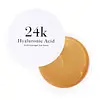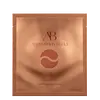What's inside
What's inside
 Key Ingredients
Key Ingredients

 Benefits
Benefits

 Concerns
Concerns

 Ingredients Side-by-side
Ingredients Side-by-side

Water
Skin ConditioningGlycerin
HumectantDipropylene Glycol
HumectantChondrus Crispus Powder
AbrasiveCeratonia Siliqua Gum
EmollientPhenoxyethanol
PreservativePEG-60 Hydrogenated Castor Oil
EmulsifyingXanthan Gum
EmulsifyingPanthenol
Skin ConditioningAllantoin
Skin ConditioningChlorphenesin
AntimicrobialTocopheryl Acetate
AntioxidantNiacinamide
SmoothingDipotassium Glycyrrhizate
HumectantDisodium EDTA
Synthetic Fluorphlogopite
Butylene Glycol
HumectantAdenosine
Skin ConditioningParfum
MaskingCI 77891
Cosmetic Colorant1,2-Hexanediol
Skin ConditioningSodium Hyaluronate
HumectantCI 77491
Cosmetic ColorantTin Oxide
AbrasiveHydroxypropyltrimonium Hyaluronate
Hydrolyzed Collagen
EmollientGold
Cosmetic ColorantSodium Acetylated Hyaluronate
HumectantHydrolyzed Hyaluronic Acid
HumectantHyaluronic Acid
HumectantSodium Hyaluronate Crosspolymer
HumectantHydrolyzed Sodium Hyaluronate
Skin ConditioningPotassium Hyaluronate
Skin ConditioningWater, Glycerin, Dipropylene Glycol, Chondrus Crispus Powder, Ceratonia Siliqua Gum, Phenoxyethanol, PEG-60 Hydrogenated Castor Oil, Xanthan Gum, Panthenol, Allantoin, Chlorphenesin, Tocopheryl Acetate, Niacinamide, Dipotassium Glycyrrhizate, Disodium EDTA, Synthetic Fluorphlogopite, Butylene Glycol, Adenosine, Parfum, CI 77891, 1,2-Hexanediol, Sodium Hyaluronate, CI 77491, Tin Oxide, Hydroxypropyltrimonium Hyaluronate, Hydrolyzed Collagen, Gold, Sodium Acetylated Hyaluronate, Hydrolyzed Hyaluronic Acid, Hyaluronic Acid, Sodium Hyaluronate Crosspolymer, Hydrolyzed Sodium Hyaluronate, Potassium Hyaluronate
Water
Skin ConditioningGlycerin
Humectant1,2-Hexanediol
Skin ConditioningChondrus Crispus Powder
AbrasiveCeratonia Siliqua Gum
EmollientXanthan Gum
EmulsifyingAllantoin
Skin ConditioningSynthetic Fluorphlogopite
Niacinamide
SmoothingPanthenol
Skin ConditioningCI 77491
Cosmetic ColorantAgar
MaskingCyamopsis Tetragonoloba Gum
Emulsion StabilisingCI 77891
Cosmetic ColorantEthylhexylglycerin
Skin ConditioningAdenosine
Skin ConditioningCalcium Lactate
AstringentGlucose
HumectantPotassium Chloride
Pentylene Glycol
Skin ConditioningSodium Phytate
Chlorphenesin
AntimicrobialRhizobian Gum
Sodium Acetylated Hyaluronate
HumectantTin Oxide
AbrasiveTocopheryl Acetate
AntioxidantCaprylic/Capric Triglyceride
MaskingHydrogenated Phosphatidylcholine
EmulsifyingHydrolyzed Rice Protein
Skin ConditioningMaltodextrin
AbsorbentCitric Acid
BufferingAlanyl Glutamine
HumectantArginine
MaskingButyrospermum Parkii Butter
Skin ConditioningCamellia Sinensis Leaf Extract
AntimicrobialSqualane
EmollientBrassica Alba Seed Extract
Skin ConditioningCeramide NP
Skin ConditioningHydrogenated Lecithin
EmulsifyingOligopeptide-177
Phenylalanine
MaskingPotassium Sorbate
PreservativeSodium Chloride
MaskingWater, Glycerin, 1,2-Hexanediol, Chondrus Crispus Powder, Ceratonia Siliqua Gum, Xanthan Gum, Allantoin, Synthetic Fluorphlogopite, Niacinamide, Panthenol, CI 77491, Agar, Cyamopsis Tetragonoloba Gum, CI 77891, Ethylhexylglycerin, Adenosine, Calcium Lactate, Glucose, Potassium Chloride, Pentylene Glycol, Sodium Phytate, Chlorphenesin, Rhizobian Gum, Sodium Acetylated Hyaluronate, Tin Oxide, Tocopheryl Acetate, Caprylic/Capric Triglyceride, Hydrogenated Phosphatidylcholine, Hydrolyzed Rice Protein, Maltodextrin, Citric Acid, Alanyl Glutamine, Arginine, Butyrospermum Parkii Butter, Camellia Sinensis Leaf Extract, Squalane, Brassica Alba Seed Extract, Ceramide NP, Hydrogenated Lecithin, Oligopeptide-177, Phenylalanine, Potassium Sorbate, Sodium Chloride
Ingredients Explained
These ingredients are found in both products.
Ingredients higher up in an ingredient list are typically present in a larger amount.
1,2-Hexanediol is a synthetic liquid and another multi-functional powerhouse.
It is a:
- Humectant, drawing moisture into the skin
- Emollient, helping to soften skin
- Solvent, dispersing and stabilizing formulas
- Preservative booster, enhancing the antimicrobial activity of other preservatives
Adenosine is in every living organism. It is one of four components in nucleic acids that helps store our DNA.
Adenosine has many benefits when used. These benefits include hydrating the skin, smoothing skin, and reducing wrinkles. Once applied, adenosine increases collagen production. It also helps with improving firmness and tissue repair.
Studies have found adenosine may also help with wound healing.
In skincare products, Adenosine is usually derived from yeast.
Learn more about AdenosineAllantoin is a soothing ingredient known for its protective and moisturizingg properties. Because of this, it is often added to products with strong active ingredients.
Studies show higher concentrations of this ingredient can promote wound healing.
Though it can be derived from the comfrey plant, allantoin is produced synthetically for cosmetic products to ensure purity.
Learn more about AllantoinCeratonia Siliqua Gum is extracted from the seeds of the carob tree. You might know this ingredient as Carob Gum or Locust Bean Gum. It is used to stabilize other ingredients and improve the texture of products.
Carob gum is made up of long-chain polysaccharides. This makes it a natural thickener.
Yes! This ingredient comes from the seeds of a tree. The name 'Locust Bean Gum' can be misleading.
Learn more about Ceratonia Siliqua GumChlorphenesin is a synthetic preservative. It helps protect a product against bacteria in order to extend shelf life. In most cases, Chlorphenesin is paired with other preservatives such as phenoxyethanol and caprylyl glycol.
Chlorphenesin is a biocide. This means it is able to help fight the microorganisms on our skin. It is also able to fight odor-releasing bacteria.
Chlorphenesin is soluble in both water and glycerin.
Studies show Chlorphenesin is easily absorbed by our skin. You should speak with a skincare professional if you have concerns about using Chlorphenesin.
Learn more about ChlorphenesinChondrus Crispus Powder is an exfoliant.
Ci 77491 is also hydrated iron III oxide. It's sole purpose is to give a red/pink hue to products.
Iron III oxides are classified as inorganic chemicals for coloring.
Synthetically created Ci 77491 is considered safer than those naturally found. This is because the synthetically created version may contain less impurities. Iron oxides are generally non-toxic and non-allergenic.
Learn more about CI 77491Ci 77891 is a white pigment from Titanium dioxide. It is naturally found in minerals such as rutile and ilmenite.
It's main function is to add a white color to cosmetics. It can also be mixed with other colors to create different shades.
Ci 77891 is commonly found in sunscreens due to its ability to block UV rays.
Learn more about CI 77891Glycerin is already naturally found in your skin. It helps moisturize and protect your skin.
A study from 2016 found glycerin to be more effective as a humectant than AHAs and hyaluronic acid.
As a humectant, it helps the skin stay hydrated by pulling moisture to your skin. The low molecular weight of glycerin allows it to pull moisture into the deeper layers of your skin.
Hydrated skin improves your skin barrier; Your skin barrier helps protect against irritants and bacteria.
Glycerin has also been found to have antimicrobial and antiviral properties. Due to these properties, glycerin is often used in wound and burn treatments.
In cosmetics, glycerin is usually derived from plants such as soybean or palm. However, it can also be sourced from animals, such as tallow or animal fat.
This ingredient is organic, colorless, odorless, and non-toxic.
Glycerin is the name for this ingredient in American English. British English uses Glycerol/Glycerine.
Learn more about GlycerinNiacinamide is a multitasking form of vitamin B3 that strengthens the skin barrier, reduces pores and dark spots, regulates oil, and improves signs of aging.
And the best part? It's gentle and well-tolerated by most skin types, including sensitive and reactive skin.
You might have heard of "niacin flush", or the reddening of skin that causes itchiness. Niacinamide has not been found to cause this.
In very rare cases, some individuals may not be able to tolerate niacinamide at all or experience an allergic reaction to it.
If you are experiencing flaking, irritation, and dryness with this ingredient, be sure to double check all your products as this ingredient can be found in all categories of skincare.
When incorporating niacinamide into your routine, look out for concentration amounts. Typically, 5% niacinamide provides benefits such as fading dark spots. However, if you have sensitive skin, it is better to begin with a smaller concentration.
When you apply niacinamide to your skin, your body converts it into nicotinamide adenine dinucleotide (NAD). NAD is an essential coenzyme that is already found in your cells as "fuel" and powers countless biological processes.
In your skin, NAD helps repair cell damage, produce new healthy cells, support collagen production, strengthen the skin barrier, and fight environmental stressors (like UV and pollution).
Our natural NAD levels start to decline with age, leading to slower skin repair, visible aging, and a weaker skin barrier. By providing your skin niacinamide, you're recharging your skin's NAD levels. This leads to stronger, healthier, and younger looking skin.
Another name for vitamin B3 is nicotinamide. This vitamin is water-soluble and our bodies don't store it. We obtain Vitamin B3 from either food or skincare. Meat, fish, wheat, yeast, and leafy greens contain vitamin B3.
The type of niacinamide used in skincare is synthetically created.
Learn more about NiacinamidePanthenol is a common ingredient that helps hydrate and soothe the skin. It is found naturally in our skin and hair.
There are two forms of panthenol: D and L.
D-panthenol is also known as dexpanthenol. Most cosmetics use dexpanthenol or a mixture of D and L-panthenol.
Panthenol is famous due to its ability to go deeper into the skin's layers. Using this ingredient has numerous pros (and no cons):
Like hyaluronic acid, panthenol is a humectant. Humectants are able to bind and hold large amounts of water to keep skin hydrated.
This ingredient works well for wound healing. It works by increasing tissue in the wound and helps close open wounds.
Once oxidized, panthenol converts to pantothenic acid. Panthothenic acid is found in all living cells.
This ingredient is also referred to as pro-vitamin B5.
Learn more about PanthenolSodium Acetylated Hyaluronate is a type of Hyaluronic Acid.
Hyaluronic Acids help moisturize, soothe, and protect the skin.
Read about common types of Hyaluronic Acid here:
Sodium Hyaluronate
Hydrolyzed Hyaluronic Acid
Hyaluronic Acid
Synthetic Fluorphlogopite is the synthethic version of mica. It consists of fluorine, aluminum and silicate.
Synthetic Fluorphlogopite is used to add volume to products.
It is considered non-irritating on the skin.
Learn more about Synthetic FluorphlogopiteTin Oxide is an inorganic oxide used to add opacity and volume to a product. In nature, it is already found in mineral form. The main ore of tin is an opaque and shiny mineral called casseterite.
Tin Oxide helps remove translucency in a product, or make it more opaque. Besides adding opacity, tin oxide is used for bulking to add volume.
Tocopheryl Acetate is AKA Vitamin E. It is an antioxidant and protects your skin from free radicals. Free radicals damage the skin by breaking down collagen.
One study found using Tocopheryl Acetate with Vitamin C decreased the number of sunburned cells.
Tocopheryl Acetate is commonly found in both skincare and dietary supplements.
Learn more about Tocopheryl AcetateWater. It's the most common cosmetic ingredient of all. You'll usually see it at the top of ingredient lists, meaning that it makes up the largest part of the product.
So why is it so popular? Water most often acts as a solvent - this means that it helps dissolve other ingredients into the formulation.
You'll also recognize water as that liquid we all need to stay alive. If you see this, drink a glass of water. Stay hydrated!
Learn more about WaterXanthan gum is used as a stabilizer and thickener within cosmetic products. It helps give products a sticky, thick feeling - preventing them from being too runny.
On the technical side of things, xanthan gum is a polysaccharide - a combination consisting of multiple sugar molecules bonded together.
Xanthan gum is a pretty common and great ingredient. It is a natural, non-toxic, non-irritating ingredient that is also commonly used in food products.
Learn more about Xanthan Gum